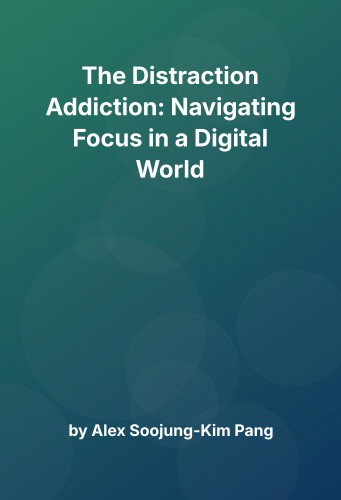The Distraction Addiction: Navigating Focus in a Digital World
In “The Distraction Addiction,” Alex Soojung-Kim Pang delves into the pervasive challenge of maintaining focus and productivity in an era dominated by digital distractions. This book offers a comprehensive exploration of how individuals and organizations can cultivate a mindful approach to technology, enhancing professional effectiveness and personal well-being. The following summary distills the book’s core themes into actionable insights for professionals seeking to thrive amidst the digital deluge.
The Paradox of Connectivity
Understanding the Digital Distraction
In today’s hyper-connected world, the very technologies designed to enhance productivity often become sources of distraction. Pang argues that constant connectivity leads to fragmented attention, reducing our ability to engage deeply with tasks. This paradox presents a significant challenge for professionals who rely on digital tools for work. The key is to recognize the dual nature of technology: as both an enabler and a disruptor.
Pang’s exploration mirrors ideas found in Nicholas Carr’s “The Shallows,” which highlights how the internet is reshaping our brains, and Cal Newport’s “Deep Work,” which argues for the necessity of distraction-free concentration. Both works stress the imperative of managing technology to preserve our cognitive capacities.
Mindful Engagement with Technology
Drawing parallels with mindfulness practices, Pang introduces the concept of “contemplative computing.” This approach encourages individuals to be intentional about their digital interactions, fostering a more deliberate and focused engagement with technology. By adopting mindful habits, professionals can mitigate the impact of distractions and reclaim their attention.
A practical analogy is treating digital interactions like a mindful meal—savoring each byte with attention and purpose rather than consuming mindlessly. This strategic engagement is akin to Newport’s advocacy for scheduled, uninterrupted blocks of deep work time.
Strategies for Digital Mastery
Developing Digital Literacy
To navigate the complexities of the digital landscape, Pang emphasizes the importance of digital literacy. This involves not only understanding how to use technology effectively but also recognizing its potential to distract. Professionals can benefit from cultivating a critical awareness of their digital habits, enabling them to make informed choices about technology use.
Crafting a Personal Technology Strategy
Pang proposes creating a personalized technology strategy tailored to individual needs and goals. This involves setting boundaries around technology use, such as designated “tech-free” times or spaces, and using tools that enhance rather than hinder productivity. By aligning technology use with professional objectives, individuals can harness its power without succumbing to its distractions.
Enhancing Focus and Productivity
The Science of Attention
Understanding the science of attention is crucial for improving focus. Pang explores how our brains process information and the impact of multitasking on cognitive performance. He draws on research to illustrate that multitasking is a myth; instead, it leads to task-switching, which diminishes efficiency. Professionals can enhance productivity by prioritizing tasks and focusing on one activity at a time.
Creating an Optimal Work Environment
An optimal work environment is essential for maintaining focus. Pang suggests designing workspaces that minimize distractions, such as reducing noise and visual clutter. Additionally, incorporating elements of nature, such as plants or natural light, can improve concentration and well-being. By creating environments conducive to deep work, professionals can enhance their ability to focus.
Embracing Digital Transformation
Leveraging Technology for Innovation
While technology can be a source of distraction, it also offers opportunities for innovation and growth. Pang encourages professionals to embrace digital transformation by leveraging technology to streamline processes and foster creativity. This involves staying abreast of emerging trends, such as artificial intelligence and automation, and integrating them into business strategies.
Building Resilient Digital Cultures
Organizations play a crucial role in shaping digital habits. Pang advocates for building resilient digital cultures that prioritize well-being and productivity. This includes promoting policies that support work-life balance, encouraging breaks, and fostering a culture of focus. By creating environments that support mindful technology use, organizations can enhance employee satisfaction and performance.
The Path to Sustainable Productivity
Balancing Connectivity and Disconnection
Achieving sustainable productivity requires balancing connectivity with periods of disconnection. Pang emphasizes the importance of taking regular breaks from technology to recharge and reflect. This practice not only enhances focus but also fosters creativity and problem-solving. Professionals can benefit from incorporating digital detoxes into their routines, allowing them to return to work with renewed energy and perspective.
Long-Term Strategies for Focus
For long-term success, Pang suggests adopting strategies that promote sustained focus. This includes setting clear goals, prioritizing tasks, and regularly reviewing progress. Additionally, cultivating a growth mindset and embracing lifelong learning can help professionals adapt to the ever-evolving digital landscape. By committing to continuous improvement, individuals can maintain their edge in a rapidly changing world.
Final Reflection: Thriving in a Digital Age
“The Distraction Addiction” offers a roadmap for navigating the challenges of the digital age. By adopting a mindful approach to technology, professionals can enhance their focus, productivity, and well-being. Pang’s insights provide a valuable framework for individuals and organizations seeking to thrive amidst the distractions of modern life. By embracing these strategies, we can transform our relationship with technology and unlock our full potential in the digital world.
This synthesis of Pang’s work with related literature such as “The Shallows” and “Deep Work” underscores the critical need for conscientious technology use. Across domains, from leadership to design, the principles of mindful technology engagement can foster environments that not only cope with but also capitalize on the digital era’s challenges. As we apply these insights, we are better equipped to lead, innovate, and thrive, ensuring that technology serves as an ally, not a hindrance, in our pursuit of excellence.

